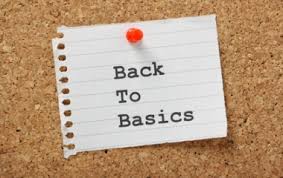Back-to-basics is an educational movement and a curriculum stressing a return of American public schools to a fundamental core curriculum based on English, mathematics, science and history. It is so-called educational “frills,” such as home economics and other personal improvement courses. Launched in the early 1970s, its roots lie in the early 20th-century “essentialism” movement that educator William Chandler Bagley developed in opposition to the progressive education movement of John Dewey.
Back-to-basics advocates would reinstitute strict classroom discipline and give primary and secondary school students little or no choice over what courses they would study. Although there are widespread differences regarding which courses constitute the required basics, they generally include those that pro- vide basic academic skills such as reading, writ- ing, spelling, punctuation, penmanship, a range of calculation skills, history and civics, biology, chemistry and physics. Some back-to- basics advocates also include music and art in their suggested core curriculum.
Proponents of back-to-basics also condemn open education and “cafeteria-style” curricula that offer students a wide choice of personal-improvement courses such as human interpersonal relations and “soft” academic courses such as media studies. Back-to-basics proponents also call for elimination of the general education track, in which 25% of the cred- its are earned for physical and health education,
Back To Basics Educational Movement: A Return to Foundations
Introduction
In the fast-paced world of education, it’s easy to get caught up in the latest trends and advancements. However, there is a growing movement advocating for a return to the basics of education. The Back To Basics Educational Movement aims to re-emphasize the importance of foundational knowledge and skills in learning. In this article, we will delve into the key principles of this movement and explore its benefits and implications for students, educators, and society as a whole.
The Importance of Foundational Knowledge
What is the Back To Basics Educational Movement?
The Back To Basics Educational Movement focuses on prioritizing the fundamental subjects and principles that form the core of education. This movement challenges the idea that learning must solely revolve around the latest technologies and innovative teaching methods. Instead, it encourages a return to the timeless skills and knowledge that have laid the groundwork for centuries of education.
Why is foundational knowledge essential?
Foundational knowledge serves as the building blocks upon which further learning can thrive. Subjects such as reading, writing, mathematics, and science provide students with a solid framework for future academic pursuits. By mastering these core subjects, students develop critical thinking, problem-solving, and communication skills that are essential for success in any field.
Benefits of the Back To Basics Educational Movement
Improved Learning Outcomes
By prioritizing foundational knowledge, the Back To Basics Educational Movement aims to enhance learning outcomes for students. A strong grasp of the basics allows students to tackle more complex concepts and subjects with greater ease. It promotes a deeper understanding of the material and fosters a love for learning, setting students on a path to lifelong education.
Equal Access to Education
The Back To Basics Educational Movement also advocates for equal access to quality education. By focusing on essential subjects, it ensures that all students have a solid educational foundation, regardless of their background or circumstances. This movement aims to bridge the educational gap and reduce inequalities by providing every student with the tools they need to succeed.
Practical Application of Knowledge
Foundational knowledge forms the basis for practical applications in real life. By equipping students with essential skills, the Back To Basics Educational Movement prepares them for the challenges they may encounter in their personal and professional lives. Whether it’s balancing a budget or solving real-world problems, a strong foundation ensures that students are well-prepared to navigate the complexities of the modern world.
Implementing the Back To Basics Educational Movement
Teacher Training and Development
To successfully implement the Back To Basics Educational Movement, educators must be equipped with the necessary tools and strategies. Teacher training programs can ensure that educators understand the importance of foundational knowledge and are equipped to deliver engaging and effective instruction in core subjects. Ongoing professional development can also keep educators up to date with the best practices in teaching foundational knowledge.
Curriculum Design and Evaluation
Curriculum design plays a crucial role in the Back To Basics Educational Movement. Emphasizing the core subjects and incorporating them into a well-rounded curriculum ensures that all students receive a comprehensive and balanced education. Regular evaluation of the curriculum helps identify areas for improvement and ensures that educational standards are maintained.
Conclusion
As the Back To Basics Educational Movement gains momentum, it reminds us of the enduring value of foundational knowledge. By focusing on the essentials, this movement empowers students to become critical thinkers, problem solvers, and lifelong learners. Embracing the Back To Basics Educational Movement not only enhances learning outcomes but also paves the way for a more equitable and prosperous society. Let’s come together to prioritize the fundamentals and build a brighter future for education.
